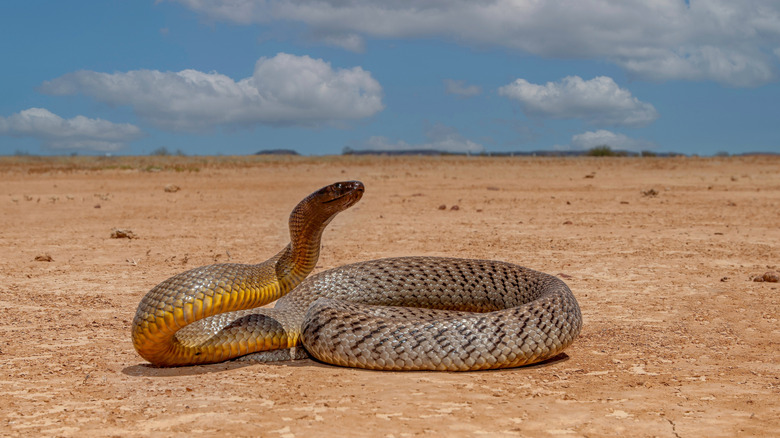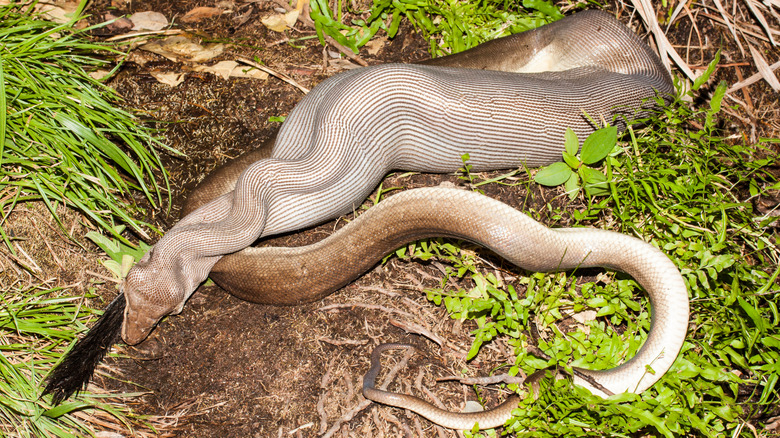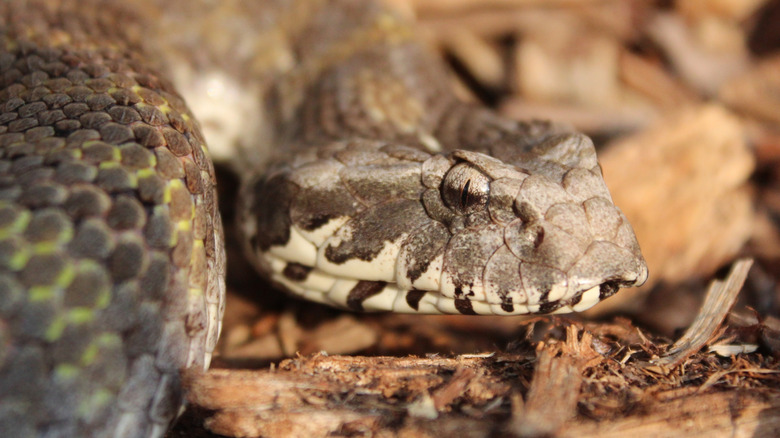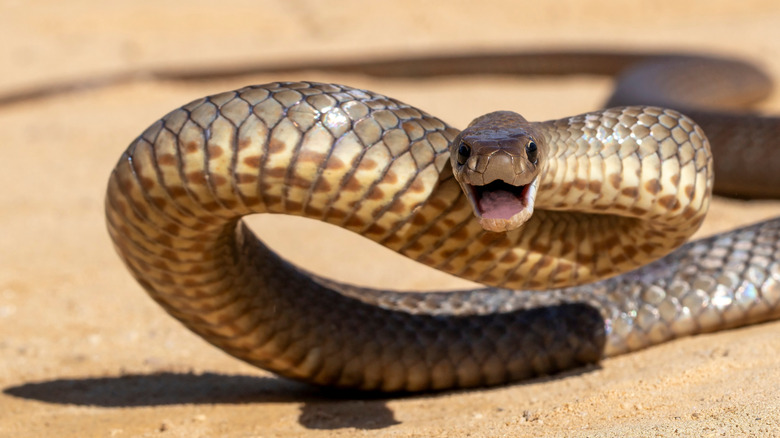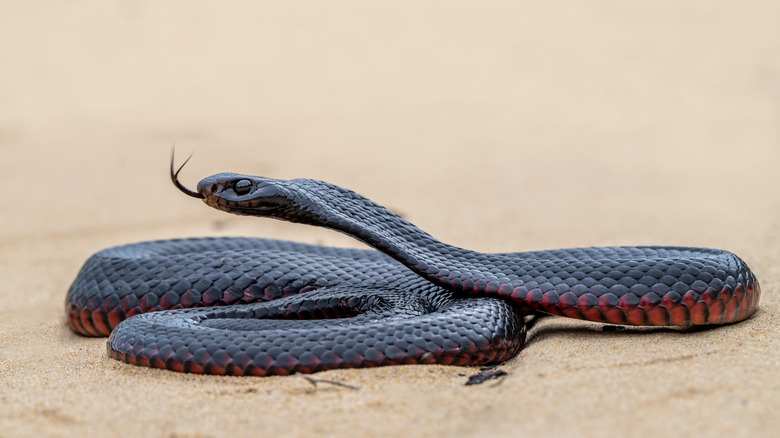These Snake-Filled Lakes And Rivers In Australia's Queensland Are Not For The Faint Of Heart
Planning a trip to see the wild wonders in Down Under? Australia is home to some of the most dangerous animals in the world, including aggressive bull sharks and snapping "salties" that thrive in the brackish waters near some of Australia's stunning beaches. While it does not have the largest number of venomous animals in the world — that dubious honor goes to Mexico — it still has an impressive array of poisonous spiders, jellyfish, and even molluscs that get in on the poison action. And that cute little egg-laying mammal, the platypus? The male of the species has venomous spurs.
Then, there are the snakes. The Australian territory of Queensland has a lot of them. That's because the so-called Sunshine State is the most biologically diverse in the country, containing more than 70% of the country's mammal and bird species, as well as over 50% of its reptiles, frogs, and plants. It has a tremendous ecological diversity, ranging from the Great Barrier Reef to tropical forests and arid deserts. It's even home to the inland taipan, the world's most venomous snake. Fortunately, this shy, brown slitherer is rarely encountered as it lives in the remote, desert areas of central Australia, burrowing into cracks and crevices.
Humans are more likely to encounter snakes in Queensland's wetter areas, particularly in rivers and lakes or coastal wetlands and forests. Here's a look at some of the territory's most notorious snake haunts. Remember to keep your distance from wild animals, especially snakes. Not only is it dangerous and potentially detrimental to your health, but it could also be illegal. Snakes are protected by law in Australia. Killing a snake is punishable by steep fines or even imprisonment. If you want to travel to a country entirely devoid of snakes, visit this popular vacation destination in Europe.
Lake Moondarra
Let's start with one of the most viral moments in snake notoriety: The 2014 incident of a huge python devouring a crocodile caught on camera. It began in the waters of Queensland's Lake Moondarra, a placid recreational area with stunning Outback views perfect for boating and swimming. This explains how a group of visitors came across a 10-foot olive python making a meal of a one-foot-long freshwater crocodile. The freshwater crocodile is a more petite version of its saltwater cousin, but can still reach lengths of up to 10 feet. However, the two reptiles were evenly matched, and the battle lasted for about five hours. The olive python, native to Australia, is a mighty snake that kills by slowly constricting around its prey and suffocating it. The snake then proceeded to tuck in by disarticulating its jaws and gulping the croc down one scaly inch at a time. Ingesting the lizard was as much of an ordeal as killing it!
Fortunately, these large brown-green snakes are completely disinterested in eating humans or anything bigger than themselves. They have no fangs or venom, only small, sharp teeth to capture prey. They are terrifyingly large, however. They can reach up to 20 feet long and weigh as much as 132 pounds. It takes a lot of heat to warm up these large cold-blooded reptiles, though. That's why they are sometimes encountered basking in the sun on hot road surfaces. Most of the time, olive pythons prefer river gorges and caves in northern Australia, such as those found near Lake Moondarra. If you encounter an olive python, back away slowly and give it a wide berth so it can slither away.
Deception Bay
This intriguingly named area of Queensland may sound like a fictional, video-game locale. Deception Bay is actually a coastal suburb about 22 miles north of Brisbane. The many scenic walks and cycle paths along its pretty coastline are just one reason this laid-back area is a popular place to live. In the 19th century, the soothing waters here drew a devoted wellness crowd with natural saltwater baths and pools. The bay is named after the deceptively shallow coastal wetland, which is, you guessed it, a favorite place for snakes.
Deception Bay, and the whole of the broader Moreton Bay ecosystem, is home to 37 species of snake, several of which are venomous. Carpet pythons are relatively common in the area, appreciated by locals as a good way to deter mice and other rodents. Several social media videos have captured prehistoric-looking pythons extending from leafy treetops to suburban rooftops, to the nonchalance of Aussie residents. Many locals learn quickly to identify snakes, distinguishing venomless pythons and keelbacks (freshwater snakes) from truly deadly serpents.
These include the appropriately named death adder, recognized by its large triangular head and thicker body. This snake is perfectly camouflaged under leaves and twigs, a favorite hiding place where it lies in wait for prey. Unfortunately, this also makes them difficult for humans to spot, especially when clearing out the back yard in this leafy suburb. The best way to avoid these snakes is to wear a pair of sturdy boots and watch your step. Move deliberately and place your feet in a clear area. Don't kick into a pile of leaves or reach in with your hands. You never know what's curled up in there.
Lake Wivenhoe
If there's one thing that will make you stay out of the water on your lake holiday, it's the sight of a giant brown snake swimming at high speed towards you. That's exactly what happened to two fishermen who were casting lines along Queensland's Lake Wivenhoe in 2021. They managed to capture the monster snake on camera, following it as it slithered into the reeds, keeping a safe distance away from the creature.
This artificial lake created by the Wivenhoe Dam has become a perfect home for snakes, including the eastern brown snake, Australia's deadliest snake. Its fangs are so small they barely leave a trace of a bite, but they pack a lot of venom. "They're the only snakes in the world that regularly kill people in under 15 minutes," Professor Bryan Fry, a snake researcher and biologist at the University of Queensland, told ABC News, "Even more insidiously than that is that for the first 13 minutes, you're going to feel fine."
Though not an especially aggressive snake, it can strike out when cornered. If you encounter one in the wild, stay calm and slowly back away from the snake, taking care not to startle it. Put as much distance as you can between yourself and the snake. Never try to flush out a snake or handle it on your own. Call in a professional snake catcher to capture it and release it back into the wild.
Mooloolah River
The Mooloolah River winds through Queensland's Sunshine Coast, known for its balmy weather and white sand beaches. The name is believed to be derived from an indigenous Aboriginal word, possibly "mullu", which is also known as the red-bellied black snake. This striking, glossy black serpent is exceedingly shy, and though poisonous, it is less venomous to humans and rarely causes death. They are equally at home on land or water. One Queensland snake-catcher was called in to retrieve a red-bellied black that had been catching waves at Mooloolaba Beach for over an hour!
Other snakes known to inhabit the area include the reclusive but deadly coastal taipan, the more aggressive cousin to the inland taipan. The coastal taipan has a ferocious bite, with fangs about half an inch long, and a rapid, repeating bite that refills its venom sacs each time. Fortunately, the coastal taipan is rarely encountered, preferring to stay far away from humans. For some snake watchers, sighting this elusive species is something to celebrate.
If the sheer amount of snakes in Australia has you worried, consider the calm reaction many locals have to finding snakes in their homes. One Australian podcaster simply continued streaming after a giant python dropped into his shot. That's because Aussies know that snakes are not chasing humans. Instead, it's the humans who have disturbed the snakes. "Over 90% of the snake bites here in Australia is caused by people trying to catch or harm the snake," says Queensland snake wrangler Shannon Mathes, demonstrating how to deal with a frightened snake on @sm_wildlife TikTok. "Snakes will always look to retreat first. So, just give them some time and space to move on and you'll be fine. If you do find yourself close, just remember to stay completely still."
